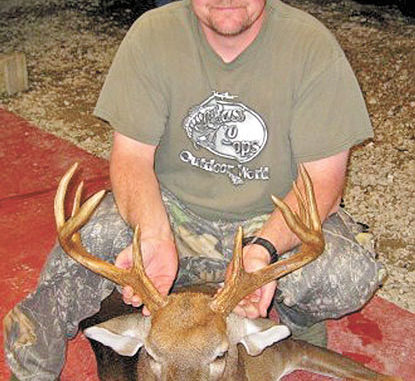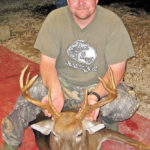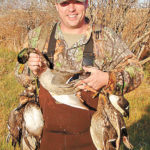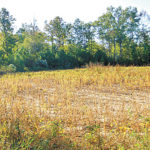
The majority of deer hunters in North Carolina and South Carolina enjoy some of the longest seasons in the entire country. In South Carolina’s Lowcountry, lucky hunters have already had the opportunity to draw blood for more than 100 consecutive days by Dec. 1.
While many hunters only check into the deer woods on occasion, many avid venison lovers perch high in the trees, clocking hours upon hours hoping for a mighty kill. No doubt, deer feel the constant pressure from outsiders rambling across their territory.
As December sets in, many deer feel the pressure immensely and redirect their feeding habitats to less-disturbed areas, and sometimes they become nocturnal. While nocturnal feeding behaviors are tough to avoid, hunters can provide sanctuary areas abundant with food, suitable cover and zero human interaction to take advantage of just before the season closes.
Deer plow a rough row in the fall, with breeding on the brain and city slickers trying to shoot them on every occasion. Deer quickly become vulnerable, with critical needs bearing down and playing a vital role in their daily activities. Basically, most does are bred, and mating is basically over for bucks as they enter another long period of abstinence.
Rich food sources quickly become critically important for both bucks and does, but unfortunately, by December, most hard- and soft-mast become scarce as well. Most agriculture fields remain fallow, with little available browse available. Food plots are over-browsed and covered with the stench of danger left from hunters. With the shortest day of the year approaching on the winter solstice (Dec. 21), cold days and nights further enhance hunger pangs among deer and other wildlife.
Hunters wishing to fill their last remaining tag with a trophy buck can take advantage of the vulnerable deer on their lands. Hunters need to provide what these deer yearn for: a safe, undisturbed, rich food source. Hunters should set aside a portion of their property with a highly-productive food plot or area for supplemental feeding to be left alone for the first two to three weeks of December. The sanctuary must have substantial heavy cover to allow deer to feel safe. The area should be left completely alone during this period, with the exception of hauling in supplemental feed. If the food plot is over-browsed, supplemental foods such as sweet potatoes are recommended since they tend to last longer and usually are deposited on site in large quantities.
Over-browsed food plots can be revived before you establish the sanctuary by following a few simple measures. The food plot in the proposed sanctuary area can be prepared with a late fertilization treatment and deer-exclusion tactics two to three weeks in advance. Combined, these treatments would allow the food plots to recover from heavy browsing and be prepared for the sanctuary period. After Dec. 1, deer-exclusion devices can be removed, and further human/dog disturbances should cease until the last week of the season.
The key to making these late-season sanctuaries a success is the abundant food and little to no disturbances whatsoever. Dogs, vehicles and any other traffic should be totally avoided. In order to adequately provide a usable sanctuary, the total area, including food plot and associated cover, should be at least 30 to 50 acres, depending on cover and available foods.
Deer are known to travel great distances to a rich food source where there’s little disturbance, especially in areas prone to heavy hunting pressure in the Carolinas. Do not be too surprised if groups of deer show up that have never been observed before, even on trail cameras. Heavy hunting pressure educates mature deer, and likewise, they learn quickly when a protected food source is available.
As the last week of the season approaches, just in time for Christmas, the sanctuary should be receiving heavy activity from many deer from near and far. Hopefully, the lack of pressure and abundant foods will offset nocturnal feeding behaviors as well. While most hunters experience dwindling daylight activity on their stands the last week of the season, sanctuary-sector hunters can possibly experience the best hunting of their season, with a chance at a real monster buck just a few days before it closes.
Ducks need sanctuaries, too
The 60-day duck season is broken into several segments, with the final term beginning in mid-December and continuing through the better part of January. While swamps, impoundments, bays and beaver ponds receive migrating flocks during the two early seasons, the final season coincides with freezing temperatures to the north and ducks blanketing the area. This last and final season should be planned strategically to have the best shoots on each visit to the duck blind. Hunters providing a temporary refuge for ducks on a rotating cycle will significantly improve their success on gunning days.
With a shorter photoperiod and foods locked under ice, ducks head into the Carolinas in search of available groceries. Just like deer and other wildlife species, ducks prefer food sources in protected areas without the constant blasting and peppering from 12-gauge shotguns. When a complex or multiple impoundments exist on a large single or group of properties, temporary sanctuaries will dynamically improve hunter success.
As long as conditions remain constant, ducks will frequent a rich food source for a prolonged span. Ducks seek out concentrated food sources. Combined with an extensive itinerary and freezing temperatures, ducks essentially are starved for food, but excessive hunting pressure will push them away from food-filled impoundments to areas that provide some sense of safety.
For the best results, each duck impoundment should be allowed a week’s rest every few weeks during the season. If impoundments have a systematic layout, sanctuary areas should be shifted to the next adjacent area to allow ducks to easily find the new sanctuary area.
In addition to hunting, sanctuary areas should be void of any disturbance if possible. The birds need to feel a sense of safety within these to encourage their return on the following days.
In addition to sanctuaries, ducks need to be allowed to feed throughout the day on hunted impoundments as well. Pounding a duck impoundment from sunrise to sunset quickly deteriorates future hunting possibilities. On gunning days, hunts should end by noon to allow birds to come in and feed in the afternoons.
For duck hunters with only one impoundment to hunt, gun days must be limited to prevent over-hunting — usually no more than one to two days per week.
Preserve bobwhite buffets
December is a time of rest for most farmers, with little field-work remaining on the to-do list. But many farmers plow up their harvested fall fields to return the residual nutrients back into the soil. While a common practice and probably a necessity at some point during the winter, delaying these activities offers several game species valuable resources during winter, especially the bobwhite quail.
For most crops, little is lost by running the disk harrow across the field in late November or December. But almost every soybean field is utilized by the bobwhite quail until it’s turned back into the soil. Even the most expensive harvesting machines spill a substantial portion of grain, and while insignificant to the farmer, bobwhite quail thrive and survive on the spilled grains intertwined with the cut stalks eight inches above the soil’s surface. Very few soybean fields in the piedmont and coastal-plain regions of the Carolinas do not harbor at least one covey of quail.
Hunters should encourage farmers to delay plowing for as long as possible. In addition to quail, wild turkey, rabbits, doves and other non-game species benefit from un-tilled soybean fields during the winter. Not only do the spent crops provide crucial nutrition for wildlife, but most fields have weedy invaders within the harvested areas. The combination of leftover crop stalks and weeds provides excellent cover for game birds and bugging areas for wild turkeys, too.
Unfortunately, many farmers feel the need to till these areas. If the entire field cannot be left un-tilled, field margins can be left until spring soil treatments are necessary. Even these small margins will help feed these animals during the winter months. In order to provide a significant food source, 25- to 50-foot un-tilled soybean field borders are recommended. As an alternative and better compromise, an agreement can be made between the farmer and hunters to leave an unharvested border around each field edge. While these borders can be narrower than the harvested borders, wider borders will provide more food for wildlife and will sustain larger groups of animals through the winter.
Farmers’ actions have direct effects to wildlife. Any conservation efforts will benefit populations of wildlife on every farm they tend, but often wildlife become nuisances within the agriculture field, decimating crops and reducing profits. But delaying post-harvesting practices will have little effect on their profitability. Encourage farmers to delay tilling to promote food and cover for small game on their farms.







Be the first to comment